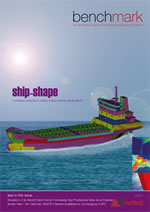benchmark July 2009
Ship-shape - numerical analysis in safety-critical marine applications

In this Issue:
It was good to meet so many benchmark readers last month at the NAFEMS World Congress in Crete. Not only was the Congress a great success in terms of the excellent technical content presented in the sessions and workshops, but events such as this allow the analysis community to come together for three days and exchange ideas, thoughts on the technology, and of course the occasional anecdote or two. What struck me most about this year’s Congress was the geographical spread of those attending – people came from every part of the globe to take part in the event, which gave all delegates the benefit of hearing about the work being done in many different countries, with different standards, regulations and cultures. A full review of the Congress is included on page 19 of this issue.
Back in January this year, I received an e-mail from a NAFEMS member asking if the Congress was indeed going ahead – apparently, rumours had been rife that the event was under threat due to the deepening economic crisis. Stories of the Congress’s death, however, were greatly exaggerated, and in the end we welcomed over 200 delegates, presenters and exhibitors to Crete. The current global recession will surely, however, inhibit the ability of some companies to allow employees to travel to such events, no matter how important and useful they are deemed to be.
Significantly, NAFEMS has recently launched a series of new “e-learning” training courses to supplement our well-established webinar offerings, to help provide access to training to everyone who can access the internet, no matter where they are located. Within the professional development arena, we are seeing a gradual move towards this type of training – the benefits, both financial and in terms of “man-time”, are clear – the ‘students’ or ‘attendees’ needn’t travel outside of their own office, and can break the training into chunks of one or two hours whenever is convenient to them.
Balancing the Virtual with the Physical
Whilst this on-demand training and seminar attendance will undoubtedly increase in the coming months, we must remember to strike a balance between ‘virtual learning’, and the more traditional methods of physically attending events. There can be no substitute for ‘networking’ into the wee small hours with prospective customers, technology partners, and even prospective employers. In an increasingly virtual world, the value of events such as the congress and other seminars and courses is even higher – when budgets are cut and travel is limited, physical events must deliver much more “bang-for-buck” and provide attendees with even more value for money.
People are, quite rightly, becoming much more discerning when it comes to choosing which physical events to attend, and the challenge for organisations such as NAFEMS is to provide unique and engaging content to maximise the benefits of attendance – something which events such as the World Congress clearly address through the high quality sessions provided.
As ever, please feel free to send me your comments on this, or any other aspect of simulation you deem worthy of discussion – as you will see in the “To The Editor” section, we’ve been encouraged by the level of feedback we’ve been receiving recently – long may it continue!
David Quinn I Editor I david.quinn@nafems.org I twitter.com/benchtweet




